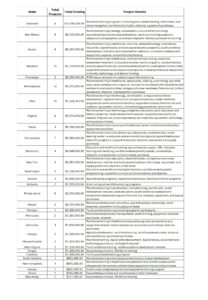
Congress recently passed a continuing resolution (CR) extending government funding through the end of the 2025 fiscal year. However, unlike a traditional “clean” CR that maintains current funding levels, this bill shifts priorities —increasing defense spending while cutting workforce development and other non-defense programs. These changes eliminate more than $183 million in funding for programs under the Department of Labor, limiting resources for training and employment services that help workers and businesses succeed.
The CR rescinded $75 million from the Dislocated Worker National Reserve, not to be confused with the Dislocated Worker Formula Grants, funded at $301 million. These critical resources support workers and communities recovering from economic disruptions, natural disasters, and public health crises through grants, such as:
Additionally, the bill eliminates $107.8 million in congressionally directed workforce funding, the same amount approved for specific projects in FY24. These cuts mean local workforce projects, targeted job training and employment initiatives will have fewer resources.
The chart below illustrates the number of projects and total funding included in the Senate appropriations for Department of Labor for FY25. Since the House did not allow community projects for the Department of Labor in FY25, only the Senate allocated funding. The chart also highlights projects that were likely to receive awards, with Delaware facing the largest loss of potential funding.
The elimination of these funds significantly reduces access to workforce training and supportive services across the country; underscores a continued underinvestment in federal workforce programs; and limits opportunities for workers and businesses Without these resources and increased investments in workforce programs more broadly, communities will struggle to connect people to in-demand careers, and help businesses find skilled workers.
With the CR finalized, Congress now turns its attention to FY26 appropriations, reconciliation, and raising the debt ceiling—all of which are expected to be contentious and will involve key funding decisions that impact workforce programs As you will recall from our recent blog The Fight for Workforce Funding: Key 2025 Deadlines Every Advocate Should Know, the reconciliation process begins with a budget resolution and requires only a majority in the Senate unlike most other legislation that is considered by the chamber. The process already began with the House and Senate advancing separate budget resolutions. The Senate passed a resolution that proposed a reconciliation process that split energy and border components from tax cuts.
The House budget resolution, on the other hand, combined energy, border policy, and tax cuts into a single package, allocating $4 trillion for a debt limit increase, $4.5 trillion for tax cuts, and deep cuts to federal programs including $880 billion in cuts to programs under the jurisdiction of Energy and Commerce Committee, $230 billion in cuts to programs under the jurisdiction of the Agriculture Committee, and $330 billion in cuts to programs under the jurisdiction of the Education and Workforce Committee. It should be noted that while the Senate initially passed a separate budget resolution, it is expected that the Senate will consider the House budget resolution at the end of March.
While the specifics of these cuts are still uncertain, it is likely that some portion of cuts will target Medicaid either through benefits cuts or work requirements which generally do not help individuals find unsubsidized employment in the long-term. Cuts are also expected to target rolling back energy tax provisions from the Inflation Reduction Act.
Rescinding investments including those focused on infrastructure and clean energy threatens ongoing projects with some projects already being put on hold in part due to uncertainty in funding.
Some Republican lawmakers in the House have voiced concerns over potential changes to energy tax incentives. More than 20 Republican legislators recently sent a letter to House leadership warning that limiting or phasing out these incentives could disrupt capital investments, raise utility costs, and undermine energy independence.
Additionally, as Congress navigates the debt ceiling debate, Democrats may leverage the Senate’s lack of a filibuster-proof majority to advance their priorities. With narrow majorities in both chambers, even a small group of lawmakers could create opportunities to resist deep cuts to workforce programs.
While the House budget, which the Senate plans to consider, includes a debt ceiling increase, the U.S. may hit the debt ceiling before Congress completes the reconciliation process leading to separate debt ceiling negotiations. Additionally, Congress will need to start working on FY26 appropriations. Both of these will require approval from 60 members of the Senate. Along with narrow House majority, Democrats may have the most leverage to negotiate key priorities including protecting workforce programs from further cuts.
Advocates should continue demonstrating the impact of workforce investments by sharing real-life stories of how funding cuts affect workers, employers, and communities. These narratives help policymakers understand the tangible, real-world value of federal workforce initiatives and build support for them among lawmakers.
Additionally, advocates are encouraged to join us in May for the Skills Summit, where we will be pressing for policies outlined in Equipping Workers, Building Futures: Federal Policies for a Skilled America.
